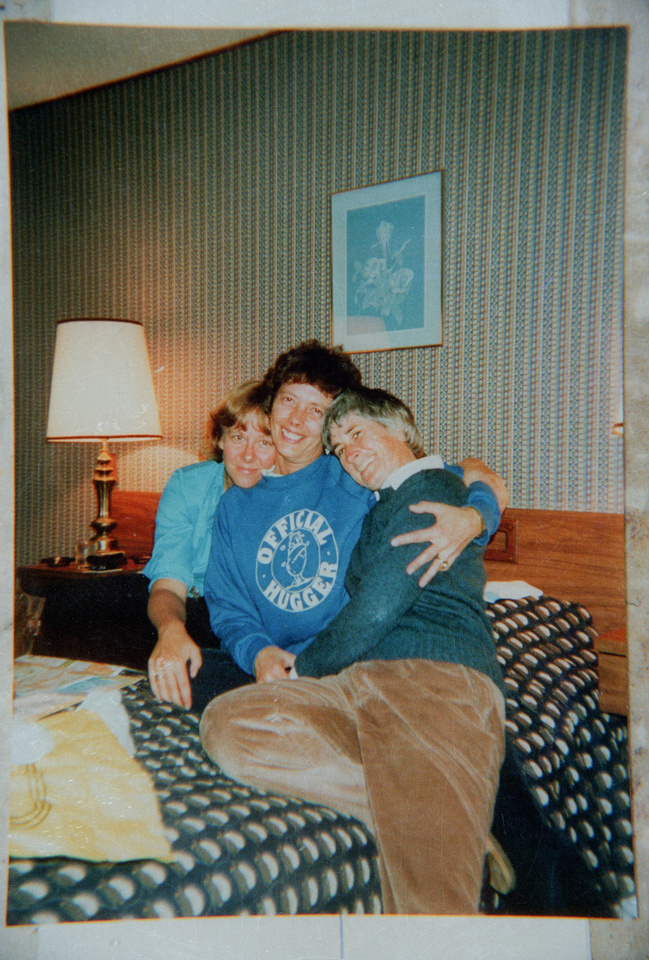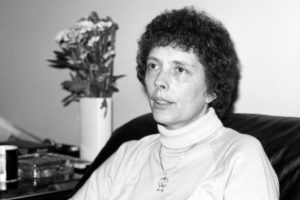Pat Turner and Kim Stabinski
All the Gay Pride and social media coverage in June prompted me to reflect on my own activism and remember good friends. Back in the 1980s, when the Conference for Catholic Lesbians (CCL) was in full force growth mode, Pat Turner was the editor of our quarterly newsletter, Images. Pat stepped up to take on the role when we needed a person with experience and professionalism. Years before, Pat had served as an editor and production volunteer for the Daughters of Bilitis’ newsletter – The Ladder.
The Daughters of Bilitis
The Daughters of Bilitis, also known as “DOB” or “Daughters,” was the first lesbian civil and political rights organization in the United States. According to legend, Bilitis was the lover of Sappho, a renowned Greek lyric poet. DOB was founded as a social and activist group by four women in San Francisco in 1955. Some of the founders wanted to remain a social group, but others wanted to agitate for lesbian rights, respect, and equality. The activist group prevailed. (The opposite eventually happened with CCL – the social group prevailed.) Both groups died out due to lack of volunteers, and an inability to reconcile original founding goals with evolving cultural changes. Living a lesbian lifestyle became more accepted and affirmed as the US became increasingly secular and shifted away from its larger Judeo-Christian religious participation.
Tall with curly brown hair, Pat Turner is a very attractive woman. She was a steady presence and spoke in a reasoned and calm way. Pat had a very gracious way of speaking and disagreeing; so she could bridge disagreements and manage deadlines without ruffling feathers. When she was a young woman, she had joined a religious community, but left after a year or two. When I met her in the mid-1980s, Pat was an executive in the insurance industry and living in Florida. She had previously been in a long-term relationship, but her partner had passed away.
Lesbian Roles
Pat talked to me about her DOB days and what lesbian life was like at that time. Women usually identified themselves as “butch” or “femme.” Pat was femme. I told her I couldn’t identify with either group. She told me that I would have been kiki (the “i” pronounced like “eye.”) The term “kiki” was generally in existence from the 1940s-1970s and described a lesbian who did not identify as either butch or femme and was both passive and active sexually. Butches were active and femmes were passive. I didn’t like the butch/femme vibe, gender roles, or the idea of not having a complete sex life, so being a kiki outlaw was fine with me.
An Unexpected Gift
Pat gave me an unexpected gift. It was a handwritten letter on the last piece of stationery she had from her DOB days. The name at the top of the paper was Kim Stabinski. Many DOB leaders used assumed names to protect themselves from threats and harassment. I remember that I asked her how she chose that name, but I can’t remember her answer. I treasured that letter as a piece of lesbian history from a friend who helped to make that history. I included it with my CCL papers, photos and memorabilia that are now housed in the Marquette University archives.
Pat recorded her memories as part of the Daughters of Bilitis Video Project by the Lesbian Herstory Archives in New York City. Pat’s interview was taped on December 31, 1987. I listened to part of her interview as I was preparing this post. It was lovely to see her and hear her voice again. Pat was mentioned in the Lesbian Herstory Archives Newsletter, #10, February 1988, as part of the East Coast DOB. Her name was noted Pat Turner (Kim Stabinski).
I looked at the August/September 1969 issue of The Ladder, and there was Kim Stabinski on the masthead. Kim Stabinski authored an article in the December/January 1970-1971 edition, “The Roman Catholic Lesbian – The Old Order Changeth.” The article is eight pages long (page 15-22) and can be read in its entirety here.
Searching for Inner Peace
There are two sections in her article that were particularly moving. One involves Catholic Lesbians and their choices about attending Mass and receiving communion; the second described an encounter with her priest and her lover. They took place in the 1960s but could easily have happened today.
“So I sat in Mass Sunday after Sunday,” she begins, “watching – often with tears – others receive the sacraments denied me. I watched my Catholic Lesbian friends: the ones who had given up completely and never attended Mass, the ones who scraped in one furtive confession a year around Easter and avoided thinking of the shut door the rest of the time, and the ones who, like me, kept going but were strangers in their own Church. Then there were the few who were apparently good practicing Catholics, attending Church regularly and receiving the sacraments while continuing to live a Lesbian life. Notable in this group were two women who were very “married” and had been for a good many years.”
“In this latter group but distinctly different were a few who attended Mass and received communion regularly without confession – a real anathema in the Church’s eyes…They had managed to rationalize in their own hearts their defiance of the legalistic Church, but acceptance of the sacraments Christ intended them to have, even though these sacraments were coming through a Church that said they had no right to them. I envied them, too – I envied their courage to trust in God’s love alone, to defy the Church that said they were “eating their condemnation” by receiving communion “unworthily.”
Longing for Communion
In November of 1969, Pat Turner said that she made one last attempt to reconcile herself and her Catholic faith. She sought out a priest at her parish and set up a schedule for counseling. “At our first session I told Father my vastly-opposed-to-Catholic views on Lesbian expression in a real love relationship. I described the emotional relationship I share with my beloved (a Catholic, by the way, of the non-confession weekly communion clan), explaining that neither of us would degrade our love via confession – but that I wanted desperately to overcome my own mental block on the legalistic Church and be able to receive communion with her. I gave Father a copy of the June/July 1969 The Ladder with my article verbalizing my religious beliefs…” The priest took the newsletter and told Pat he wanted to discuss her and her situation with some other priests just out of the seminary and more versed on the newer trends in theology. Several weeks later, “after circulating The Ladder and soliciting the counsel of other priests, Father gave me the glad tidings – from that day on, my relationship with my beloved was not a matter for confession.” However, he did caution Pat that should she “fall into temptation and be unfaithful to my ‘better half,’ then that would be a matter for confession. That night, right there in Father’s study, sitting on the couch under full lights and looking him in the eye, rather than in a dimly lighted cubbyhole confessional box, I made my first confession in seven years. I confessed those things I believed to be sinful. I did not confess my love.”
Later that evening, when her lover came to pick up her, Pat motioned her to park the car and join her in Father’s study. Pat’s lover had been very anxious about her counseling sessions, fearing that they might either affect their relationship or Pat’s relationship with God.
“It was about 9:30 on the night of November 18 when the three of us together entered the deserted sanctuary, darkened except for myriad flickering votive lights and the outside lights playing through the stained-glass windows. My love and I knelt in silent, grateful prayer as Father made the necessary preparations, then approaching the altar where we received our Lord in Holy Communion – together for the first time.”
Being Whole and Authentic
“Later we walked down the aisle hand in hand, followed by a priest smiling the smile of one who knows he has helped – really helped – drawn a soul nearer to God…My love and I talked later of how this experience was almost like being married in the Church, so rich was its depth and feeling of togetherness with God and with each other.”
The “richness” Pat described is the richness of being whole, being authentically who you are – both Catholic and Lesbian and sharing that spiritual life and identity with another. It is as much a melding together as sex.
I cannot remember if Pat discussed this experience at any of our CCL meetings or get togethers, but I felt very grateful to her reading her article in The Ladder. Thank you, Kim Stabinksi, for the example of your faith and courage.
Pat Turner participated in the Lesbian Herstory Archives’ Daughters of Bilitis Video Project. She was taped December 31, 1987. You can listen to her interview here.
Kim Stabinski’s article, “The Roman Catholic Lesbian…The Old Order Changeth” can be read here.


